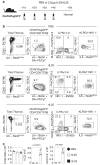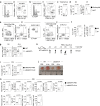The alarmin IL33 orchestrates type 2 immune-mediated control of thymus regeneration
- PMID: 37938566
- PMCID: PMC10632327
- DOI: 10.1038/s41467-023-43072-x
The alarmin IL33 orchestrates type 2 immune-mediated control of thymus regeneration
Abstract
As the primary site of T-cell development, the thymus dictates immune competency of the host. The rates of thymus function are not constant, and thymus regeneration is essential to restore new T-cell production following tissue damage from environmental factors and therapeutic interventions. Here, we show the alarmin interleukin (IL) 33 is a product of Sca1+ thymic mesenchyme both necessary and sufficient for thymus regeneration via a type 2 innate immune network. IL33 stimulates expansion of IL5-producing type 2 innate lymphoid cells (ILC2), which triggers a cellular switch in the intrathymic availability of IL4. This enables eosinophil production of IL4 to re-establish thymic mesenchyme prior to recovery of thymopoiesis-inducing epithelial compartments. Collectively, we identify a positive feedback mechanism of type 2 innate immunity that regulates the recovery of thymus function following tissue injury.
© 2023. The Author(s).
Conflict of interest statement
The authors declare no competing interests.
Figures







References
Publication types
MeSH terms
Substances
Grants and funding
LinkOut - more resources
Full Text Sources
Molecular Biology Databases
Research Materials

